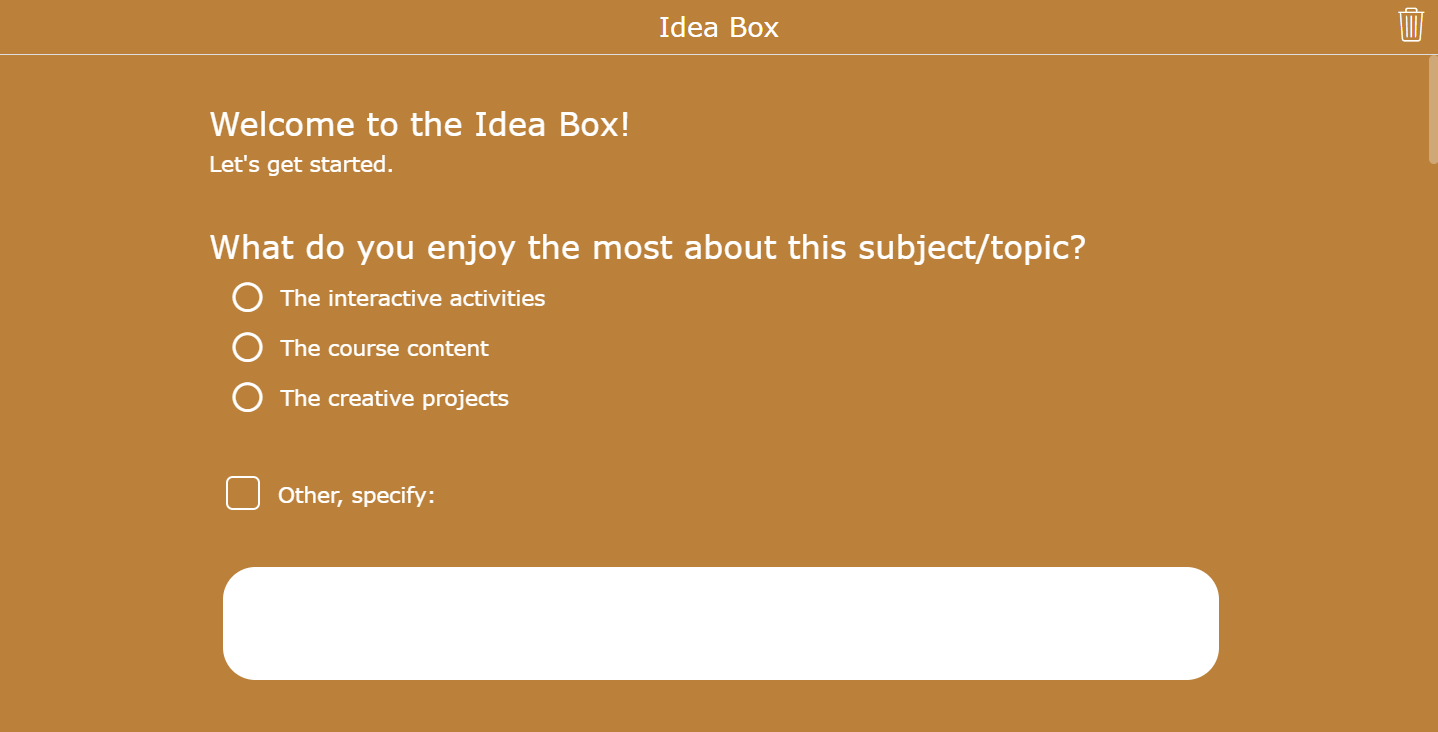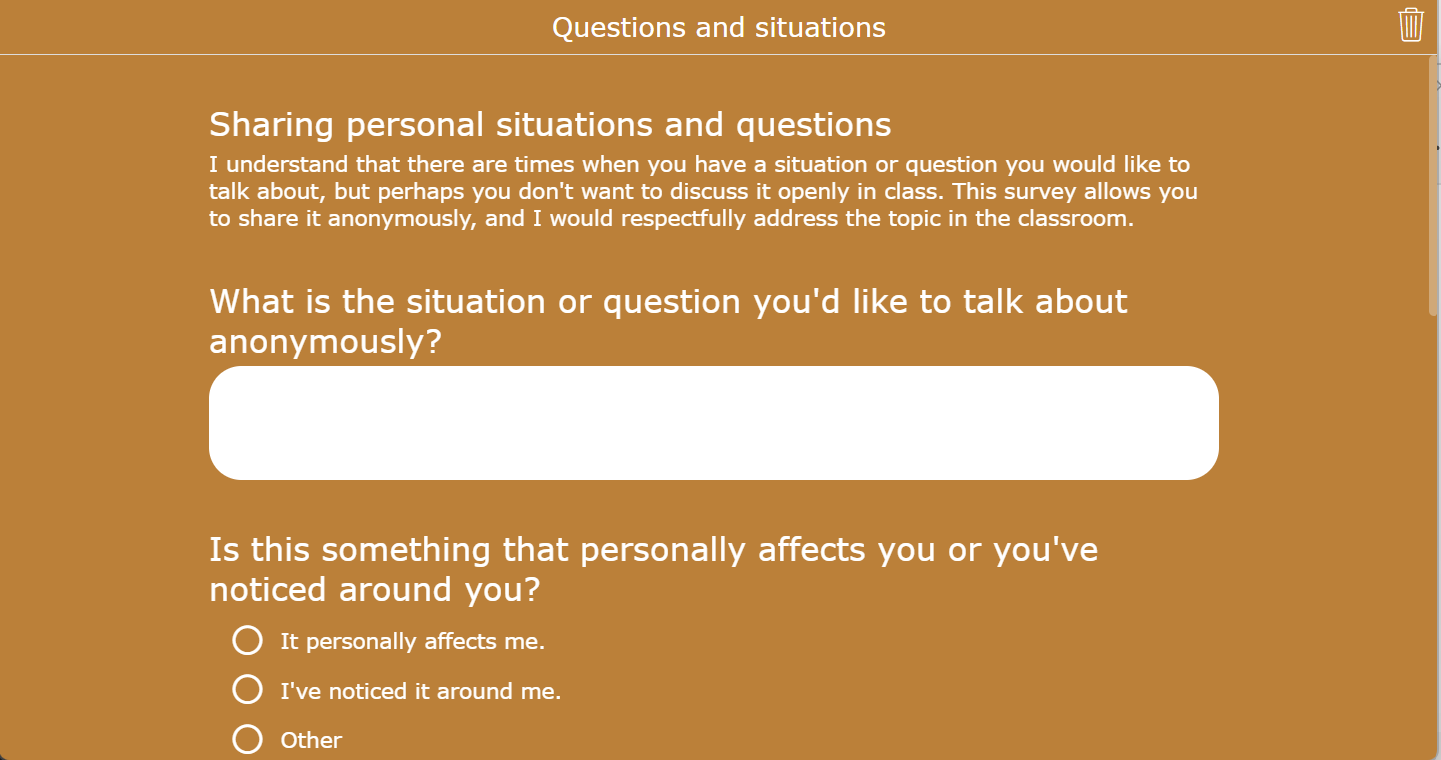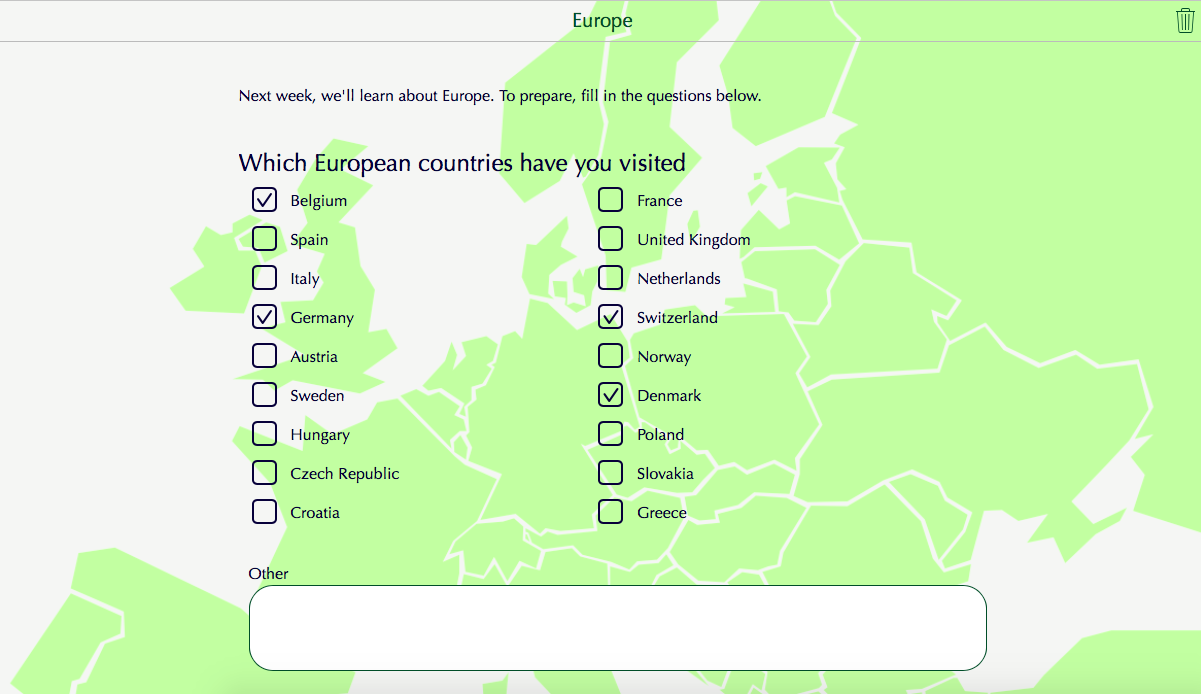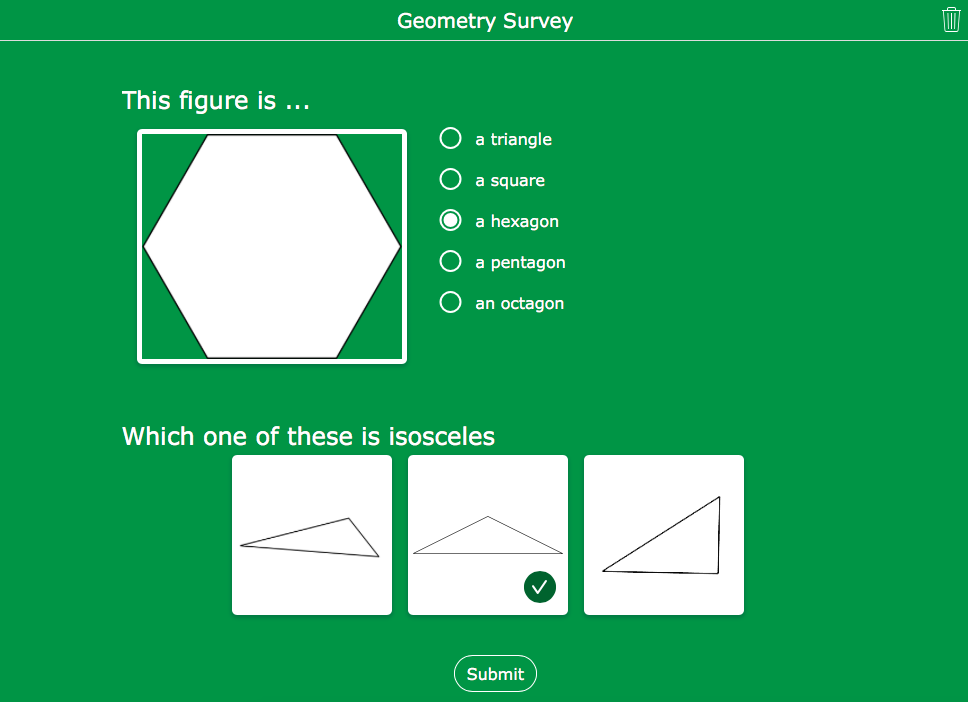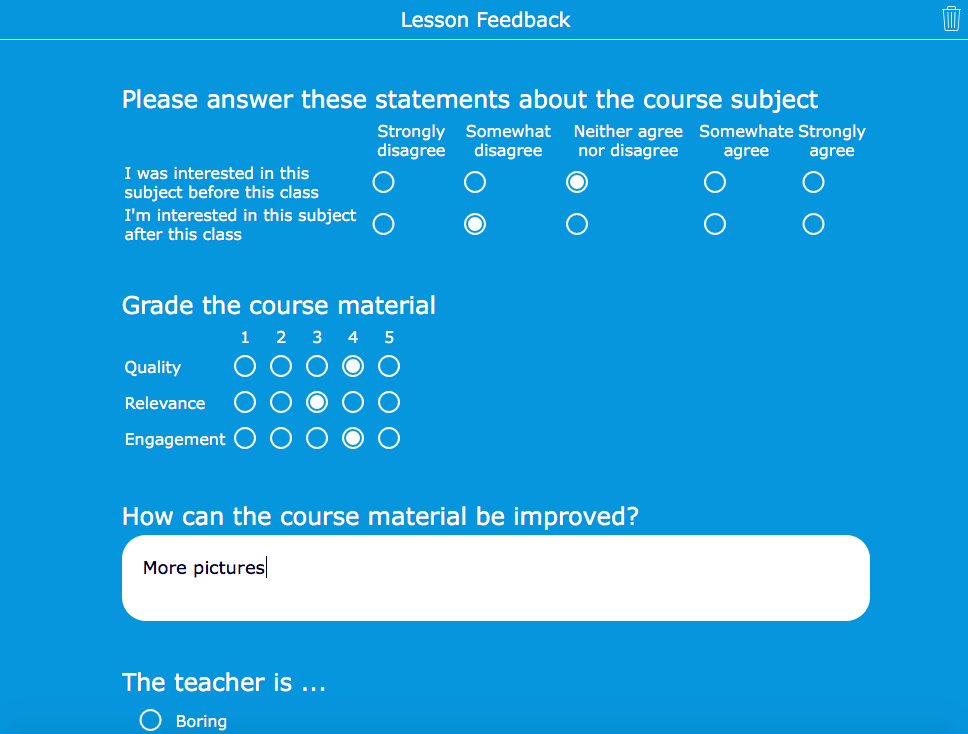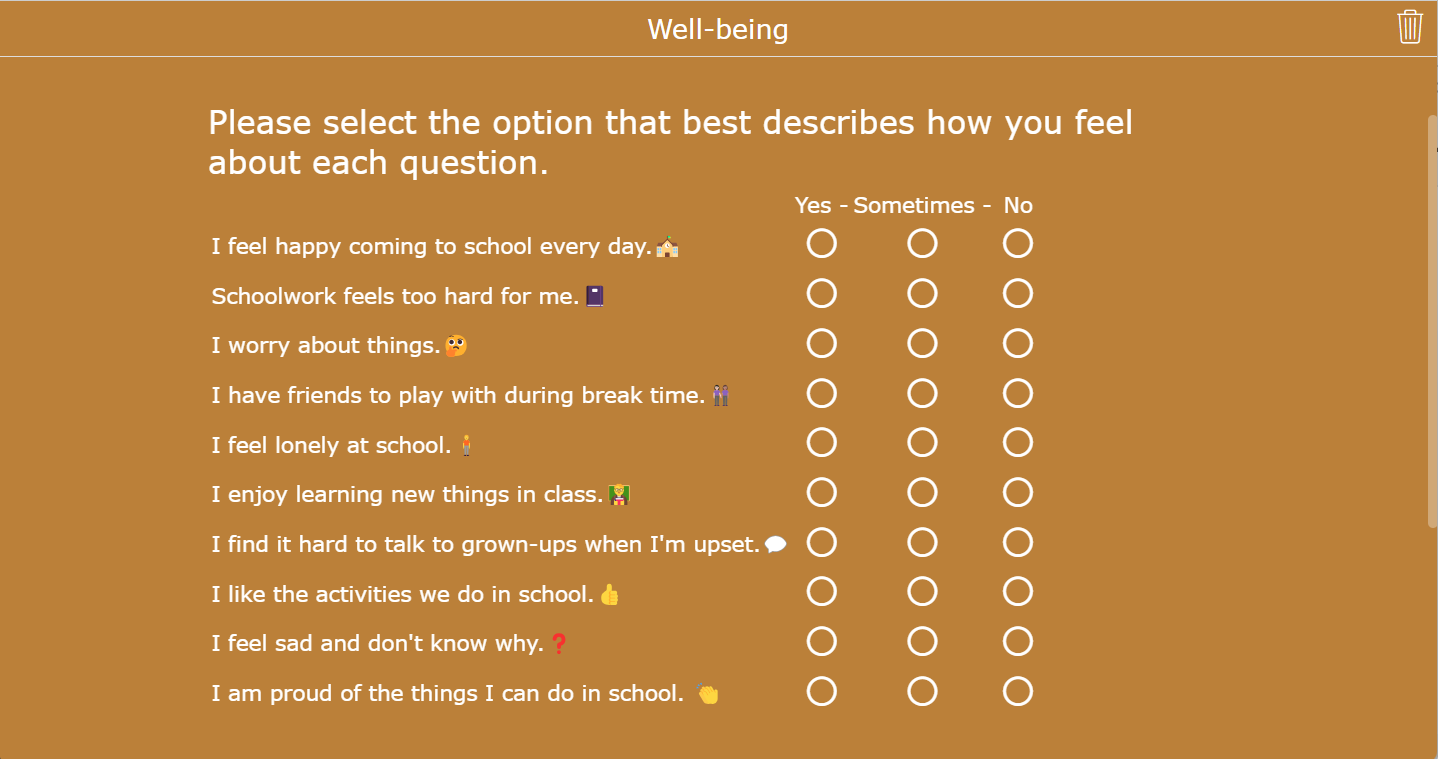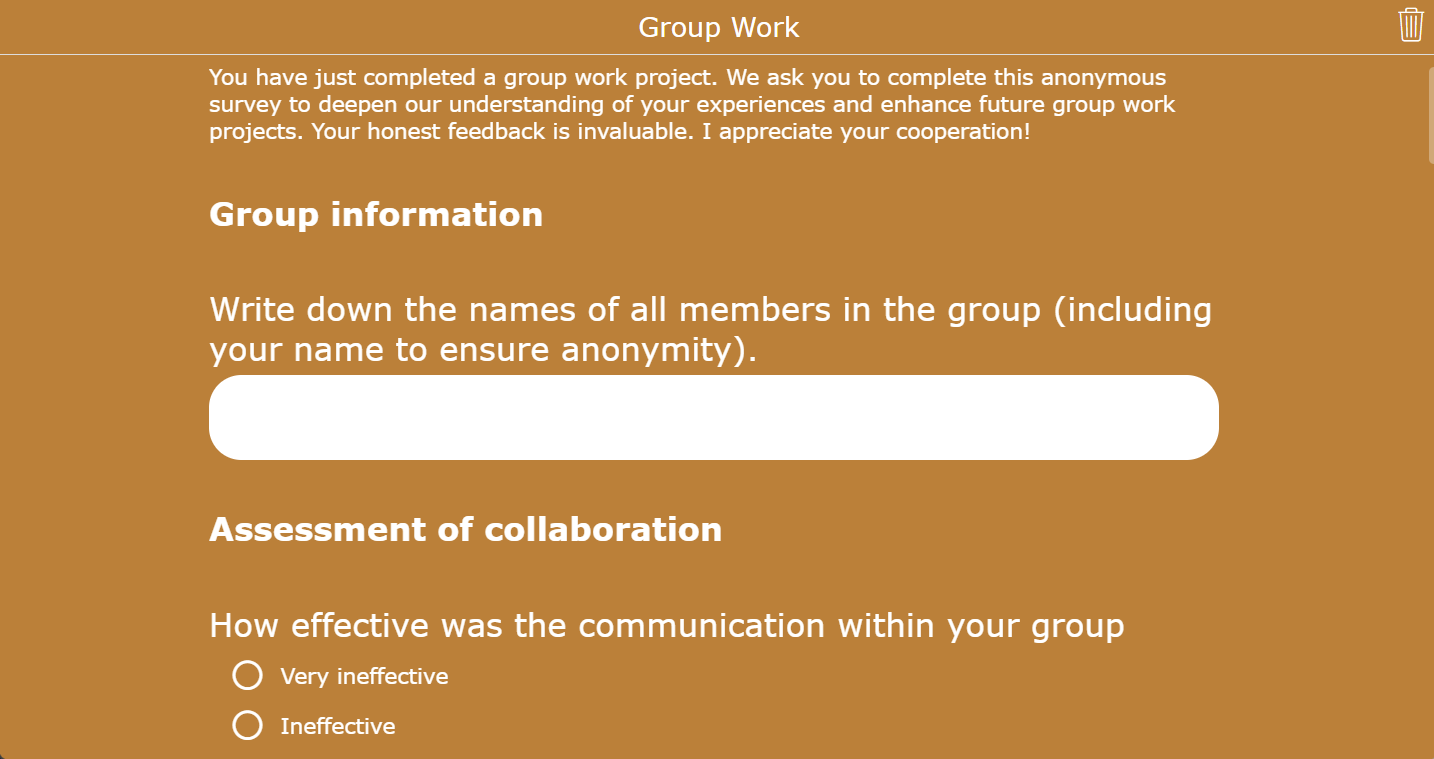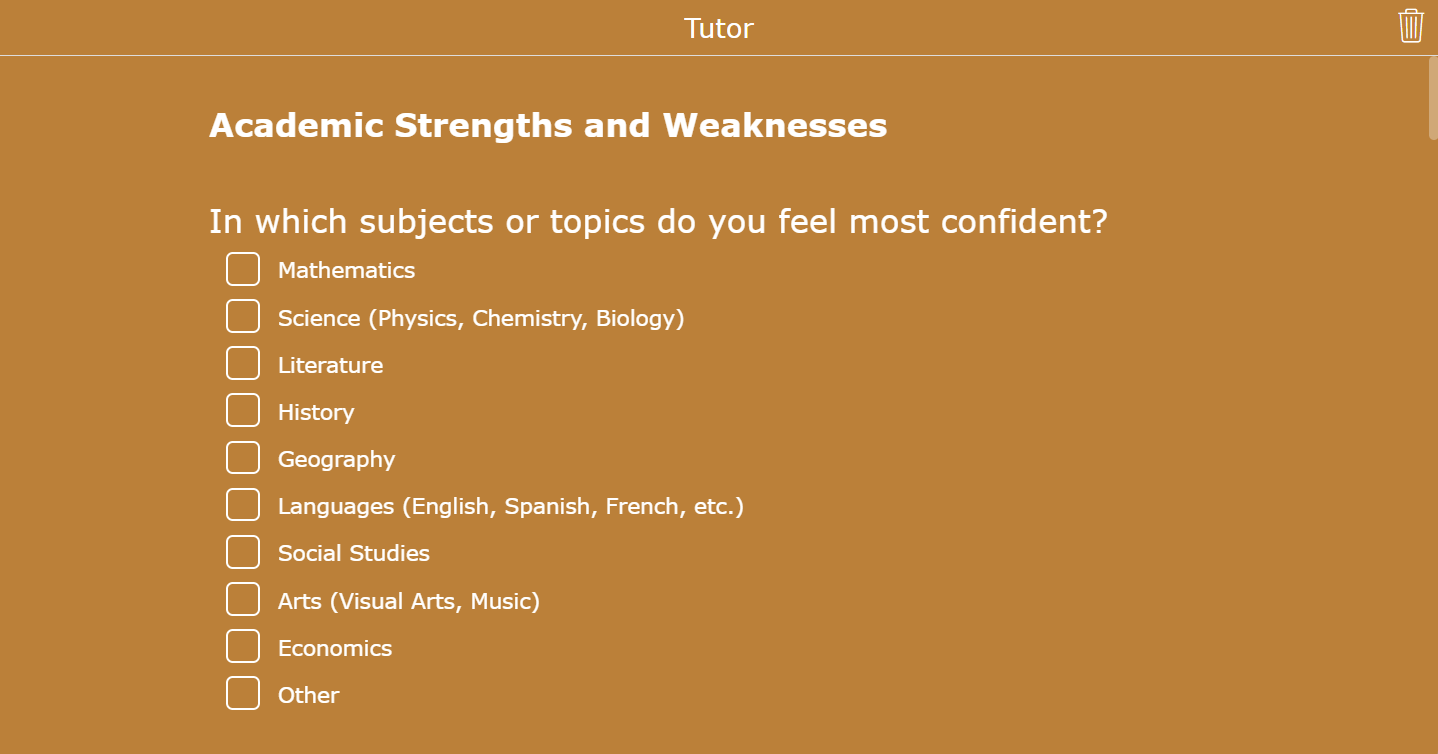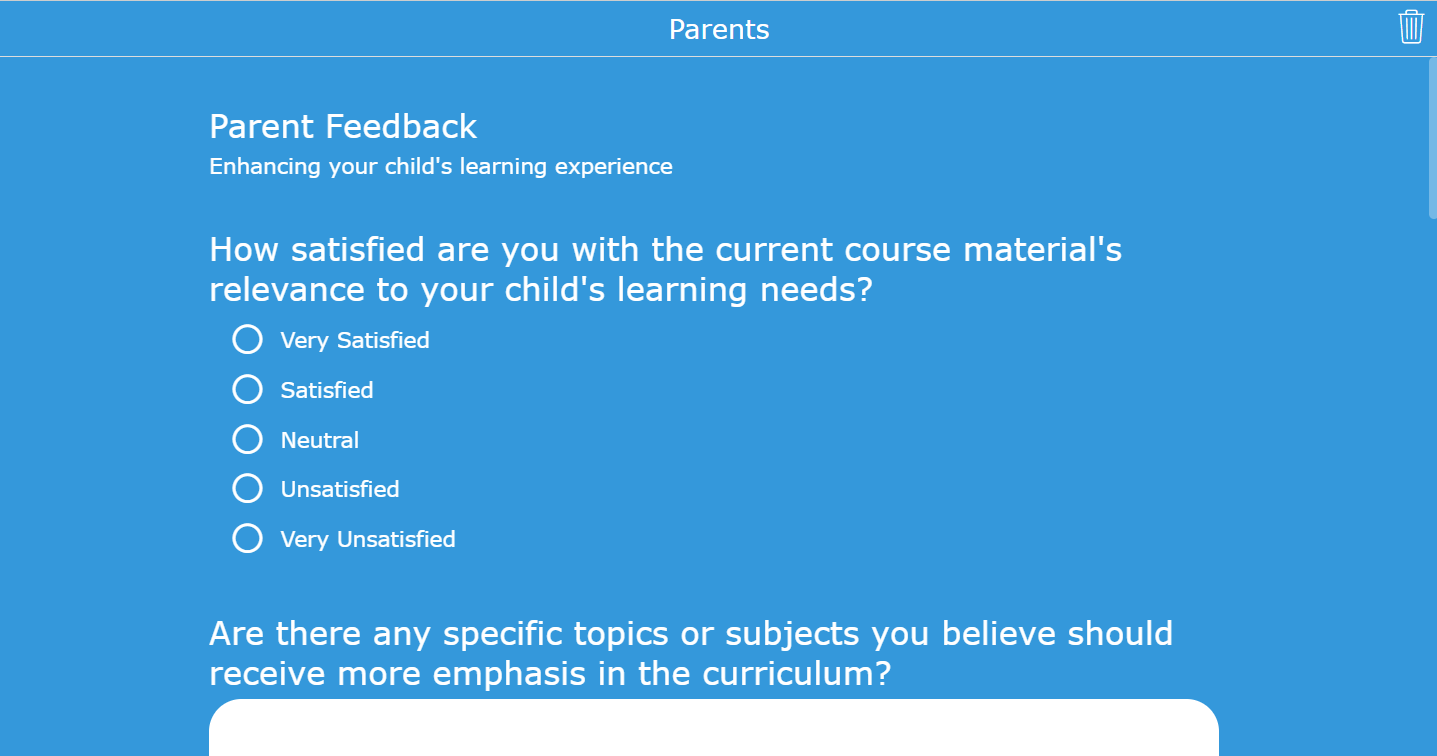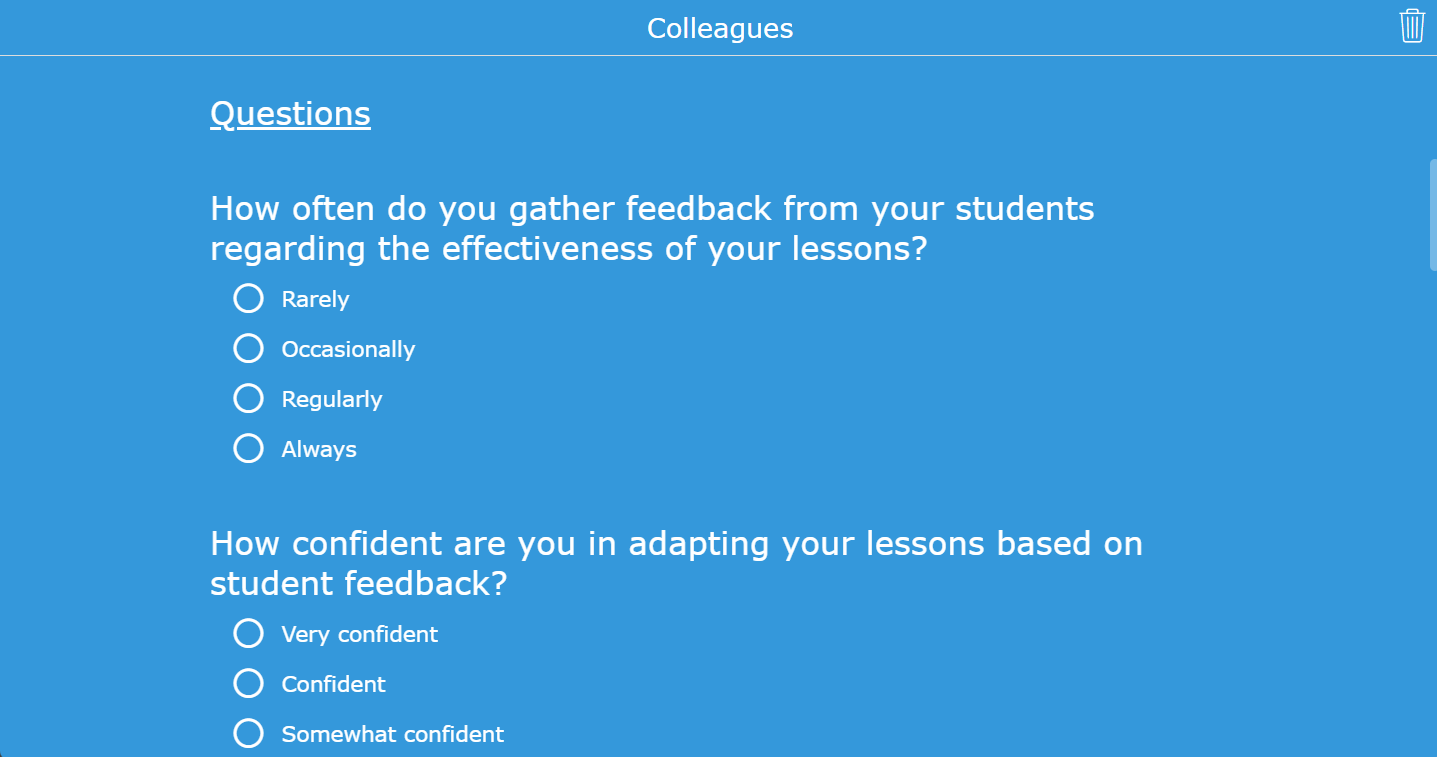10 Interesting Ways Teachers can use Surveys in the Classroom
 Remko Tronçon —
Remko Tronçon —
We talk a lot about automatically graded exercises on this blog: students complete an exercise on their tablet or PC, fill in their name, and submit it to you for review.
Sometimes, however, you don’t really care who is sending in what. All you need is to ask a few questions, and get an overview of what your students answered. No need for names, email addresses, …, just hit ‘Send’ and be done with it.
What you need is a survey. In this post, I’ll walk you through some of the things you can do with online surveys, by using the Form/Survey widget.
Surveys for substantive aspects
1. Allowing student input in lessons
 Student input contributes to enhancing the learning experience. The “Idea Box - Survey” presented below offers the possibility for students to express their thoughts regarding lessons. Through student involvement, their motivation to learn can increase. Additionally, as a teacher, you have added inspiration to enhance and refine lessons.
Student input contributes to enhancing the learning experience. The “Idea Box - Survey” presented below offers the possibility for students to express their thoughts regarding lessons. Through student involvement, their motivation to learn can increase. Additionally, as a teacher, you have added inspiration to enhance and refine lessons.
2. Fostering dialogues on tough situations and questions
 Students might find it challenging to share their thoughts at all times. Nevertheless, there are certain topics crucial to talk about. In order to facilitate discussions about these significant subjects, I’ve created a sample survey as an illustration.
Students might find it challenging to share their thoughts at all times. Nevertheless, there are certain topics crucial to talk about. In order to facilitate discussions about these significant subjects, I’ve created a sample survey as an illustration.
After sending your students a link to a survey you created, they can fill it in on their device, and hit the ‘submit’ button. As you’ll see when submitting the above survey yourself, surveys are anonymous. This means your students don’t have to be scared to tell the truth.
3. Preparing students for a class
 Surveys can be a great way to introduce a subject in your classroom.
You ask questions to trigger their curiosity, or simply poll for
opinions on the subject.
Surveys can be a great way to introduce a subject in your classroom.
You ask questions to trigger their curiosity, or simply poll for
opinions on the subject.
Another interesting thing to do is sending your students a survey a few days before your class (or at the end of the previous class), asking them questions that can help you guide where to focus your next lesson on.
4. Testing subject knowledge
 The standard way of testing how well your students master the subject
is to let them complete a quiz. However, if you prefer
to not track your students individually, and you don’t need to send any
personalized feedback, you can use short surveys to test for classroom knowledge:
The standard way of testing how well your students master the subject
is to let them complete a quiz. However, if you prefer
to not track your students individually, and you don’t need to send any
personalized feedback, you can use short surveys to test for classroom knowledge:
By looking at the aggregated results, you can draw conclusions on which parts of the subject have been well-understood, and which ones need repeating:
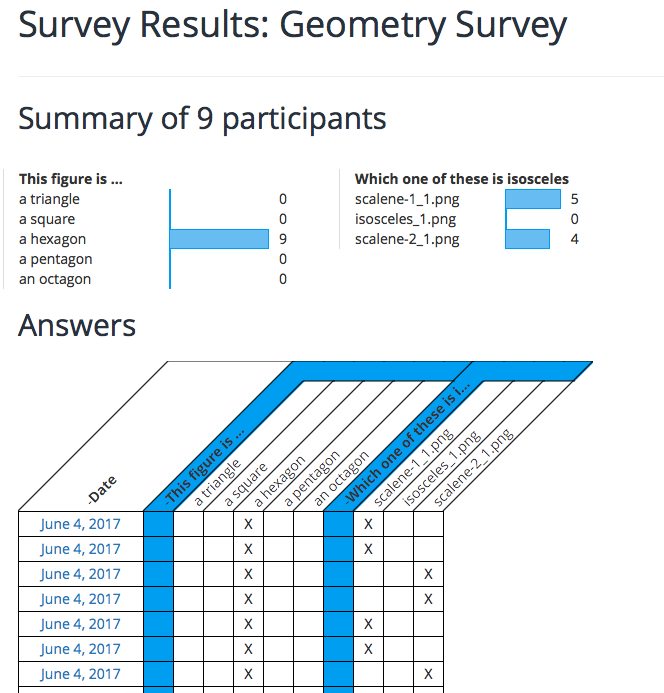
In this case, the names of the polygons seem to be well-known, but it might be useful to revisit the properties of triangles in the next class.
Surveys for Student Feedback
5. Lesson Feedback
 Every teacher wants to know what their students think about their class
and their teaching. Well, maybe not every teacher, but at least some of
you want to improve and tailor your lessons based on feedback.
Every teacher wants to know what their students think about their class
and their teaching. Well, maybe not every teacher, but at least some of
you want to improve and tailor your lessons based on feedback.
Doing a short survey after a class can be a great way to find out how your students feel about what they just learned, or how it was presented to them. You can create such a survey by combining different question types. For example:
Every answer sent in by the student is sent to your email address (unless you don’t want this, of course), so you can collect your answers and get notified when new ones come in. We also collect all answers on the BookWidgets website, where you can get a high-level overview of all submitted answers, and drill into the details:
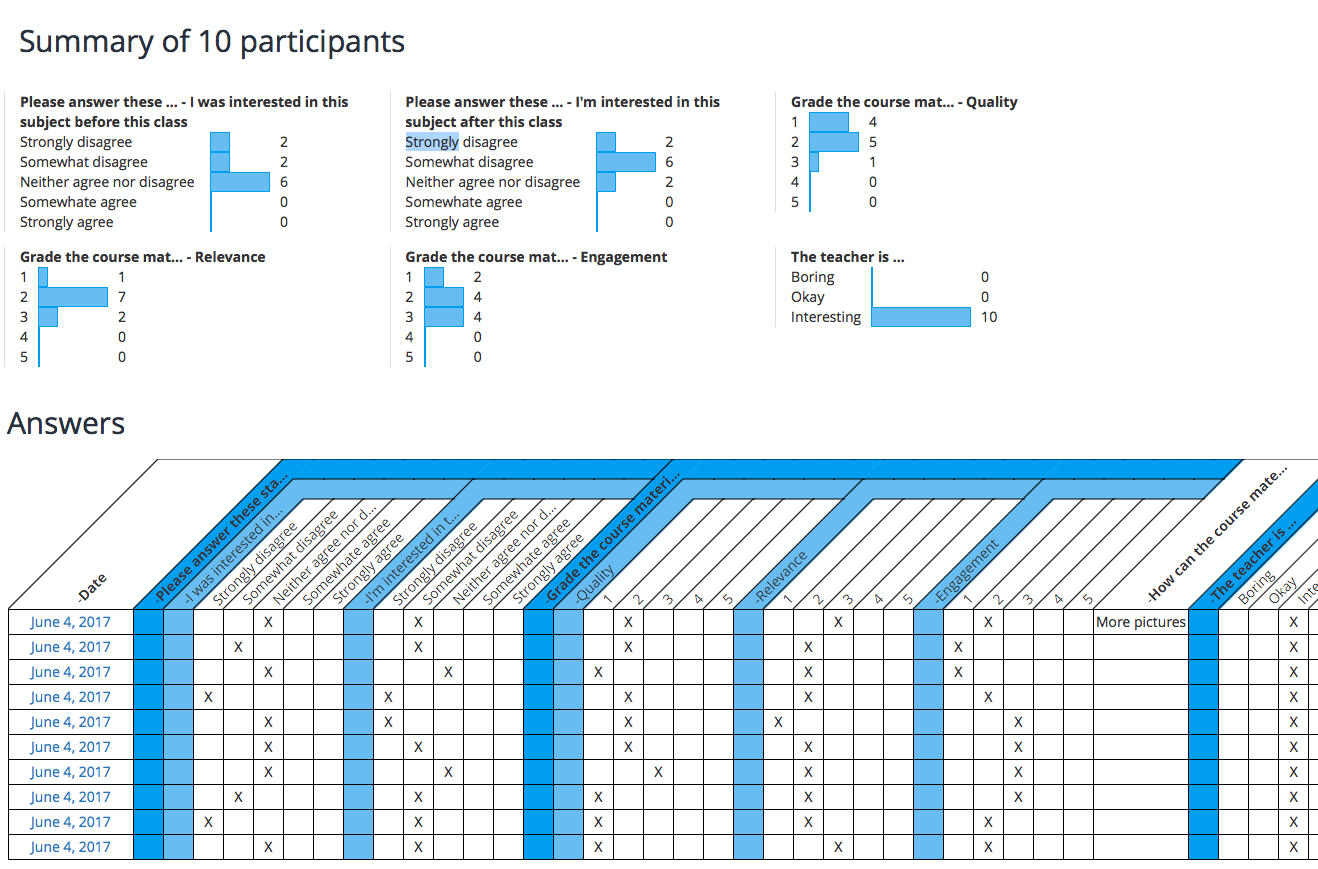
Well, at least they liked you.
6. Emotional well-being of students
 As a teacher, you have the opportunity to observe your students regarding emotional well-being. Of course, this method doesn’t guarantee the correct interpretation. A survey can complement your observations effectively, offering validation or correction if you misinterpret things. Because it is anonymous, students might feel more comfortable to share the truth. This enables a clearer understanding of the overall classroom well-being.
As a teacher, you have the opportunity to observe your students regarding emotional well-being. Of course, this method doesn’t guarantee the correct interpretation. A survey can complement your observations effectively, offering validation or correction if you misinterpret things. Because it is anonymous, students might feel more comfortable to share the truth. This enables a clearer understanding of the overall classroom well-being.
7. Assessment of group collaborations
 Collaborative projects are everywhere, and that’s a good thing because they help us build valuable skills that are part of what’s important for the 21st century. Yet, tracking group dynamics isn’t always straightforward. Peer evaluations are a common approach, but have you considered using a survey? This offers a general overview of the group’s progress and the teacher remains unaware of which group member submitted that particular survey. The approach enables teachers to review the evaluation in a more unbiased manner.
Collaborative projects are everywhere, and that’s a good thing because they help us build valuable skills that are part of what’s important for the 21st century. Yet, tracking group dynamics isn’t always straightforward. Peer evaluations are a common approach, but have you considered using a survey? This offers a general overview of the group’s progress and the teacher remains unaware of which group member submitted that particular survey. The approach enables teachers to review the evaluation in a more unbiased manner.
8. Optimizing learning through student-tutor pairing
 Utilizing a survey is valuable for acquiring insights that facilitate the creation of a strong and compatible pairing. This structured approach provides a systematic means of collecting details, thereby enhancing the informed and strategic nature of the matching process.
Utilizing a survey is valuable for acquiring insights that facilitate the creation of a strong and compatible pairing. This structured approach provides a systematic means of collecting details, thereby enhancing the informed and strategic nature of the matching process.
Surveys for feedback from others
9. Feedback from parents
 Involving the parents of your students in your class can also change
the way you teach your class. By sending them an interactive survey, you
can query parents’ opinions and thoughts on subjects like the
course material, learning environment, … And at the
same time, you give them a taste on how you use technology in your classroom.
Involving the parents of your students in your class can also change
the way you teach your class. By sending them an interactive survey, you
can query parents’ opinions and thoughts on subjects like the
course material, learning environment, … And at the
same time, you give them a taste on how you use technology in your classroom.
10. Feedback from colleagues
 You can tailor your lessons based on feedback from students and their
parents. Of course, if you have many peers, they can help in guiding
how you structure your lessons too. By asking them questions about their
courses, or teaching to a specific class, you can get insights into
You can tailor your lessons based on feedback from students and their
parents. Of course, if you have many peers, they can help in guiding
how you structure your lessons too. By asking them questions about their
courses, or teaching to a specific class, you can get insights into
Creating your own Survey widgets
Want to create your own online surveys? Just hit the button below, sign up, and start creating Survey widgets (and many other widget types) with a free BookWidgets trial.
Ending notes
Incorporating surveys into education offers insights, strategy enhancement, and informed choices. Discover the survey’s potential, and join our online community for added inspiration. For more educational insights, follow us on Twitter.


